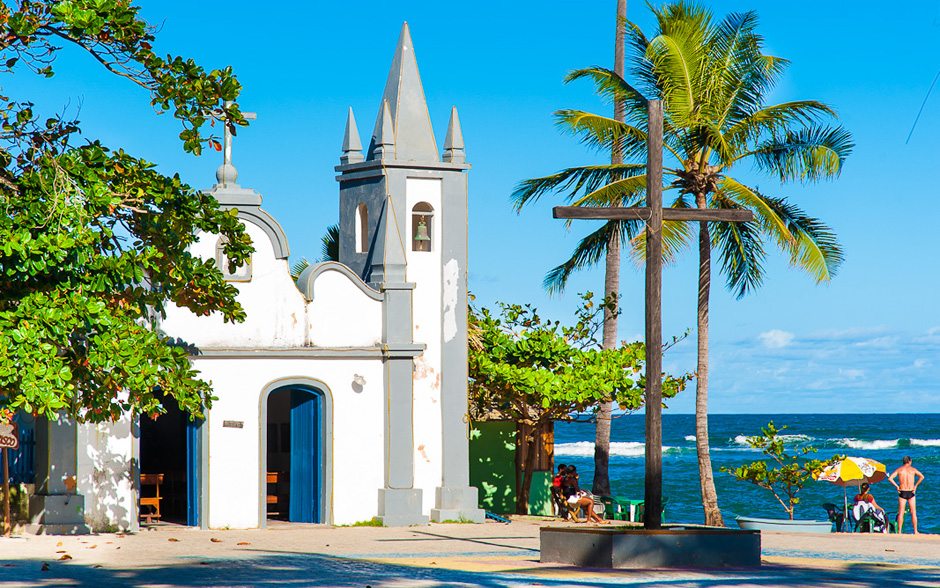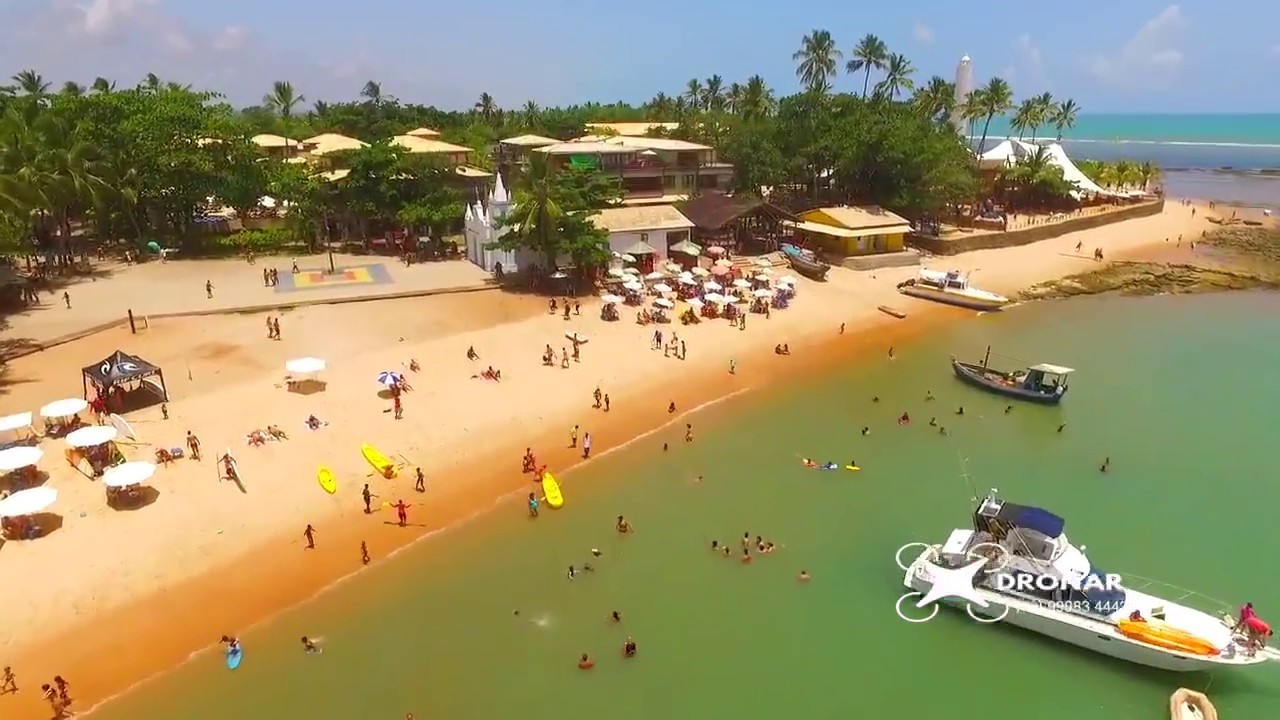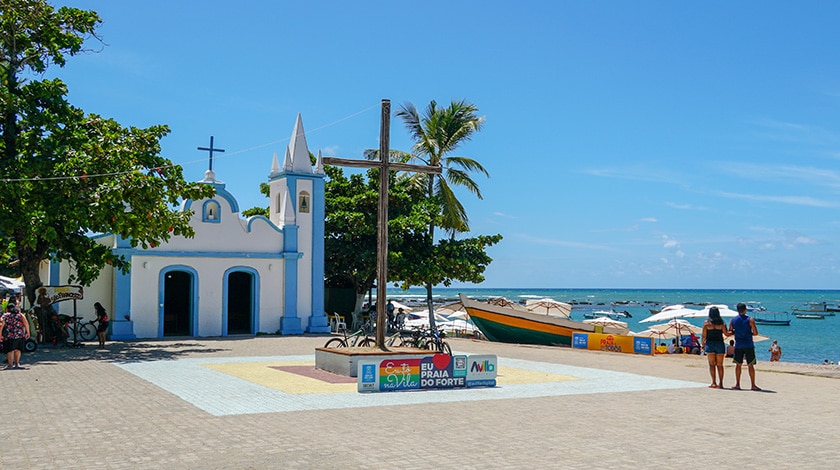Este post também está disponível em:
Português
English

Praia do Forte is an unmissable destination for those who are going to do tourism in Bahia, which is an old fishing village, with beautiful beaches, natural pools, coconut trees, lagoons, waterfalls, trails and ecological reserves.
The charming Vila full of beautiful stores, cafes, bars and restaurants is the main point for visitors arriving from different parts of the world to visit the place.
Located on the Costa dos Coqueiros, north coast of Bahia, 56 km from Salvador International Airport, 75 km from the Bus Station and 80 km from the Historic Center of Salvador, Praia do Forte has an excellent infrastructure that allows it to accommodate its illustrious visitors well.
Its hotel structure is excellent with more than a thousand beds ranging from resorts to hotels and high-class inns, as well as hostels, campsites, apartments, houses and apartments for rent.
It has a gastronomy of the best quality, designer stores, remarkable history, strong culture, ecological tours and lots of extreme sports.

Videos about Praia do Forte in Bahia


Praia do Forte - Guia de Turismo

Praia do Forte - Dicas

Vila da Praia do Forte12:34

Praia do Forte

Praia do Forte - Projeto Tamar

Praia do Forte - Drone

Praia do Forte e Imbassaí - O que fazer?24:03

História do Castelo Garcia D'Ávila ou a Casa da Torre25:49
View the Costa dos Coqueiros map
Praia do Forte Tourist Attractions
1. History of Praia do Forte
The old fishing village gave rise to what is now Praia do Forte, a place that still preserves rustic characteristics, with exquisite details and modernity.

It is believed that the formation of the village began around the fortress that the Portuguese nobleman Garcia D’Ávila had built, still in the 16th century, to give more protection to the place.
Its purpose was to store goods that arrived on the coast of the colony by sea and would later be sent to Salvador.
Many families began to settle in the region attracted by the arrival of coconut seedlings that the Portuguese colonizers brought from Asia.
Some men dedicated themselves to planting and harvesting, others became sailors helping to cross people and goods on the Pojuca River, and still others dedicated themselves to fishing. It was the beginning of the settlement of the lands near the Fort.

The first Portuguese military and residential fortification in Brazil, the Castelo Garcia D’Ávila or Casa da Torre, as it is also called, is one of the most important and significant monuments of Brazilian historical and cultural heritage.
Due to its medieval characteristics, it is considered the only building of its kind in the Americas.
The Castle began to be built in 1551 by Garcia D’Ávila, who arrived in Bahia in 1549, with the first governor general Tomé de Souza. It was listed by the National Historical and Artistic Heritage Institute – IPHAN, in 1938.
Today it is one of the main tourist attractions of Praia do Forte. Represented by its ruins, the Castle offers the visitor a beautiful view of the sea.

The Capela de São Pedro dos Rates is the oldest – and best preserved – part of the historic Castle. Known as the Chapel of All Saints, it gave rise to the seat and was only completed in 1624.
In 1835, the entire complex was abandoned by the descendants of Garcia D’Ávila. After the recovery works, in the 1980s, the Castle was transformed into a foundation and today functions as the Garcia D’Ávila Historical Park.
There is a museum on site that shows the entire process of the recovery works of the ruins and has a precious collection of Portuguese crockery and indigenous pieces that were recovered during the excavations and cataloged by Iphan.
The park is visited by students and receives thousands of tourists annually.
Another postcard of Praia do Forte is the Chapel of São Francisco de Assis. The little church, now completely restored, is located in front of Porto beach. They say it was built by fishermen in 1900.
On the altar are the images of St. Francis of Assisi, St. Benedict and Our Lady of Conception, and on the walls canvases by the Bahian painter Carlos Bastos depicting the Way of the Cross.
Its privileged location, composing with the sea and the boats, is the ideal setting for weddings, not only of the natives, but of visitors from various parts of Brazil who choose Praia do Forte to marry.
2. Nature
Nature is lavish in this region. Praia do Forte is surrounded by wonders of nature, in addition to the Atlantic Forest, beautiful beaches with good places for surfing and the famous natural pools are attractive to everyone.
The ecological walks in the Sapiranga Reserve, located 6km from Praia do Forte, is all good.
A transition area between the restinga and the Atlantic Forest, it is 600 hectares of secondary forest, totally preserved, with rare species of fauna and flora, such as the star tamarin, the anteater, almost half a hundred types of birds, orchids and bromeliads.
The walk continues towards the rapids of the Pojuca River, which offers a refreshing swim.
In the reserve several tours and radical adventures are carried out, among them, quadricycle, horseback riding, cycling, zip line, floating on buoys, kayak, motorized canoe and to finish the tours you can enjoy a peaceful bath in the Açu lagoon.
3. The Village at Praia do Forte

The Vila is the point and heart of Praia do Forte. Charming, cool, it is the place of footing, where young people, children and gentlemen stroll without compromise.
A little chat here and there or a cold drink here and a little dinner there and finally … It all ends in a famous bar or local café.
With trendy and designer stores, Vila da Praia do Forte is marked by good taste in its ambiance.
The place has a special charm where the rustic combines with the sophisticated creating a summer climate that enchants visitors throughout the year.
In addition to enjoying the beauties of a tropical place, tourists have at their disposal an excellent complete infrastructure of leisure, services and products. Praia do Forte is pure diversity. The difference is that in the village there are no cars, only bicycles and the famous bicitaxi.
In the village, the gastronomy has a special highlight, there are dozens of bars and restaurants with a variety of mouth-watering options. They offer from the famous beijús of the flour house and the delicious delicacies of the baiana de acarajé to the most sophisticated cuisines, such as French, Italian and Japanese.
The nightlife of Praia do Forte is full of joy, music and beautiful people circulating in the bars, which bustle until dawn. For those who like quieter programs, the option is to go out for a night walk, especially on full moon days.
It is in the village that you will find the Chapel of St. Francis of Assisi, one of the most famous postcards of Praia do Forte.
Located in front of the beach of the Port, where the fishing boats are anchored. Many festivals, and popular manifestations, were born around the church, among them: Branch, Comedies, Patron, Caretas, Reisado and Puxada de rede.
4. Beaches
Beautiful beaches with warm water, natural pools, white sand, vast coconut groves and calm sea. These are the characteristics that make Praia do Forte an unforgettable destination, with landscapes for all tastes. Get to know a little of each one:
One of the most popular spots is the Papa Gente Beach, with its not very shallow pools that allow delicious dives to contemplate schools of colorful fish.
Next to Papa Gente we have Praia do Lord. At low tide a large natural pool is formed where you can drink and enjoy delicacies of Bahian cuisine served to bathers in the sea.
Praia do Porto is in front of the church of São Francisco de Assis and full of stalls serving Bahian delicacies. Fishing boats are moored there. Almost a bay, ideal for swimming and for the children’s party.
For walks by the sea, the ideal beach is that of the Eco Resort.
You can go to Itacimirim or Guarajuba and, on your return, take a swim in a reserved and quiet place, with small waves and a pier in the middle of the sea. Ideal beach for wind surfing.
This is Praia do Forte. There are many wonderful places for swimming. It is difficult to choose the best… Come and discover your favorite beach.
5. Tamar Project in Praia do Forte
Praia do Forte is the main sea turtle nesting region in Brazil. There are seven types of sea turtles in the world, four of which have been laying their eggs on the beaches of Papa Gente for thousands of years.

This monitoring is done by the base of the Tamar-Ibama Project, which has been based in Praia do Forte since 1980, with the most complete and modern visitor center in the country.
It consists of the Turtle Museum, aquariums, tanks, restaurants and store.
The Tamar is located in the fishermen’s village, near the Lighthouse.
The spawning season takes place between September and May and is monitored, on the thirty kilometers of beach, by the institute’s base in Praia do Forte. More than nine hundred spawning grounds are protected by them. The entire extension is considered a Comprehensive Study Area (AEI).
The Tamar Base operates in an area of ten thousand square meters and integrates an important area, formed by remnants of the Atlantic Forest.
Also in the project area, there is a cultural program for the local population and visitors. The Project operates daily, including Sundays and holidays, from 09:00 to 17:30.
6. Humpback Whale Institute

Created in 2000 with the aim of monitoring and conserving the humpback whales in Brazilian waters, the Institute based in Praia do Forte is made up of a team of biologists prepared to receive these illustrious visitors, who arrive from Antarctica fleeing the cold waters in the period from July to October.
Praia do Forte has become an area of concentration and reproduction of these mammals.
During the “baleiada”, an activity developed to spot these animals on the high seas, visitors have the opportunity to observe beautiful acrobatics with whales that reach up to 16 meters in length and 40 tons, a true spectacle of nature on the Bahian coast.
Before the tour, lectures are given, where it is possible to obtain information about the mammal, such as habits, behavior and curiosities. Inside the Humpback Whale Institute there is also a museum available for visitation.
The Institute is open from Tuesday to Saturday, from 12h to 18h, including holidays.
7. Sapiranga Reserve

For lovers of ecotourism and adventure tourism, the options are ecological walks in the beautiful Sapiranga Ecological Reserve, formed by six hundred hectares of Atlantic Forest and natural habitat of different species of native flowers and plants, including orchids and bromeliads.
The tours through the reserve can be done in several ways such as: walking, bicycle, horse and for those who prefer more adventure, the best option is the quad bike. All trails are signposted.
8. Garcia D’Ávila Castle or the Tower House

One of the main tourist attractions of Praia do Forte is the majestic ruin of the Garcia D’Ávila Tower House.
One of the main monuments of the Brazilian historical and cultural heritage, considered the first great Portuguese building in Brazil.
Praia do Forte bears this name because it houses a medieval-inspired castle perched on a maritime observation point 2.5 km from the coast. Its ruins date back to 1551.
Built by one of the largest Brazilian landowners of that time, the ruins of the castle, which has been listed by Iphan (National Historical and Artistic Heritage Institute) since 1937, are open to visitors – and have framed several events in Brazil.
At the request of João 3º, then king of Portugal, Garcia D’Avila 1º erected what he called “Torre Singela de São Pedro de Rates“, a tribute to his hometown.
He then built the manor house and the chapel of Our Lady of the Conception.
With 26 rooms and two halls, it was only completed in 1624 by Garcia D’Avila’s grandson, the nobleman Francisco Dias de Avila Caramurú.
At the time, the fortress, known as Casa da Torre, served as a kind of military base to defend Salvador, then the Brazilian capital.
Any approach of suspicious vessels was monitored and reported by a system of torch signals seen in the so-called City of Bahia, 70 km from the fort.
In the book “Bandeirantes e Sertanistas Bahianos”, historian Francisco Borges de Barros stated that it was the only medieval-style castle built in America – and that, due to the division of the Hereditary Captaincies, it also hosted the largest latifundium in the world, with an area of 800,000 km2 (equivalent to 1/10 of the Brazilian territory).
For comparison, it is similar to the areas of Portugal, Spain, the Netherlands, Italy and Switzerland combined.
Dutch invasions
In 1637, the castle played a leading role in the fight against the second invasion by the Dutch, who wanted to consolidate their hold on Pernambuco.
The castle was then a resting point for troops, night watch and communication by light signals.
His participation in the defeat of the Dutch, who were expelled in 1645 with the help of England, was so great that in 1641 Garcia D’Avila 2º was awarded the rank of Captain of the Ordinances, granted by the Portuguese crown for services rendered by his father during the war.
Garcia D’Avila is also credited with bringing zebu cattle and coconuts to Brazil.
And, if the popular saying “without a roof or a roof” referred to the finishing of the roofs in the houses of those who did not have possessions, money and power in the colonial era, the Garcia D’Avila family house was complete: it had a roof, a roof and a roof.
His son, Francisco Dias de Ávila, continued the construction of the castle in 1624. The residence later became known as Castelo Garcia D’Ávila and Casa da Torre.
For more than 200 years, the only fort in Brazil and the only building based on the medieval style in Latin America was home to the wealthiest families and slave owners.
9. Other attractions of Praia do Forte
Praia do Forte has a privileged location for the tourist who comes to Bahia, paradise is surrounded by beautiful beaches, which can be visited by tourists who come to spend more days.
Visitors in addition to enjoying all the attractions of Praia do Forte can move to other locations through tours scheduled by receptive agencies, cabs, own or rented transportation, or even career buses and vans. It is up to each one’s taste.
The tourist, staying in Praia do Forte, can visit Salvador and return on the same day, since the distance is only 80 km from Historical Center of Salvador. Unmissable trips can be made to the beaches of the Green Line.
In the direction of the state of Sergipe it is very worthwhile to visit the beach of Imbassaí, which in Tupi means: “path of the river”, but for the locals this name has another meaning: “meeting of the waters”.
The river runs parallel to the sea forming a beautiful scenery that contrasts with the white sand dunes and the coconut grove. 7 km from Praia do Forte, Imbassaí is admired for its sunsets, kayaking and raft trips.
In Imbassaí the request is to stretch to Diogo and Santo Antonio. The village of Diogo is a quiet and peculiar place, whose community survives on the handicraft of coconut straw, piassava and fishing.
Further on you arrive at Santo Antonio, one of the attractions of the region for the semi-deserted and isolated location are the extensive dunes and coconut groves.
The tour continues, the next stop is the Costa de Sauípe, where the Sauípe complex is installed, formed by a group of five-star resorts and luxurious condominiums of houses.
Nature lovers and naturists can stop at Massarandupió beach, where there is a nudist colony. The deserted and rustic beach has lush vegetation. The place is a separate attraction for visitors. Next come Subauma and Palame-Baxios, quiet spots with long beaches.
The destination is now towards Mangue Seco with obligatory stops in Barra do Itariri, Sítio do Conde, Siribinha, Barra do Itapicuru, Costa Azul… Places that have beautiful beaches and beautiful mangroves.
Mangue Seco 170 km from Praia do Forte is the second biggest attraction of the region. The place became famous for Jorge Amado’s novel “Tieta do Agreste”, for its beaches of rugged beauty, framed by white dunes, coconut trees and primitive landscapes of river and sea.
Mangue Seco is located in the north of the Bahian coast, on the banks of the Real River, on the border between Bahia and Sergipe. One of the great local attractions are the buggy rides through the dunes and the local village, which is poorly lit, on full moon nights offers beautiful scenery.
Southbound
Prepared and on the way to the city of Salvador, the stops begin at the beaches of Itacimirim, where the sea is ideal for surfing. In Guarajuba, there is a large number of condominium houses, which make up a family atmosphere.
The local beaches, very quiet, are excellent for swimming. Barra do Jacuípe, where the river meets the sea, is ideal for jet-skiing.
We arrived in Arembepe, a village that became famous in the 70s, mainly for the hippie village that has received illustrious visits, such as Jane Joplin and Mick Jagger.
It is worth mentioning that all locations have good infrastructure for accommodation and good restaurants.
Praia do Forte Tourism and Travel Guide in Bahia



















